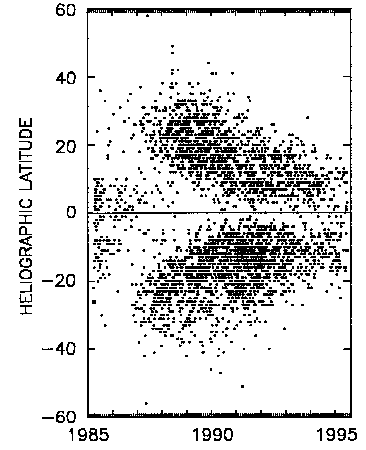
Below is a diagram of sunspots and the heliographic (solar) latitude at which they formed throughout Solar Cycle 22.
The diagram shows the solar latitude of sunspots observed in both northern and southern hemispheres. The location of sunspots shows a steady drift from higher latitudes early in the solar cycle towards lower, more equatorial, latitudes at the end of the cycle.
At the left during 1985-86, there is a cluster of points at low latitudes belonging to the end of the butterfly wings for the previous cycle, Cycle 21. During this period both cycles co-existed, with the higher latitude regions "belonging" to Cycle 22 and the equatorial ones to the new Cycle 22. Latitude is a good indicator of whether the spot belongs to the "old" cycle or to the "new" cycle. The other indicator is the magnetic structure of the sunspot groups. With the change from one cycle to the next the polarity of the leader and trailer spots of bi-polar sunspot groups is reversed.
The official time of "solar minimum" is defined by the minimum of the "smoothed sunspot number" variation. The smoothed sunspot number is the sunspot number averaged over 12 month periods centred on a given time. For example, the smoothed sunspot number for June 2006 is an un-weighted average of the monthly sunspot numbers from January to December 2006. This smoothing is done in order to remove the shorter time-scale (on the order of weeks) variation in sunspot number. So the official solar minimum is only seen with a degree of hindsight.
The arrival (or non-arrival) of new cycle sunspots however can give a very good indication about when the solar cycle will end. For the past few solar cycles, the first sunspots were seen at high latitudes 13-19 months prior to the official sunspot number solar minimum. So, when finally we see the first sunspots at high latitudes of Cycle 24, then we will know that solar minimum is around 13-19 months away.

Material prepared by Andrew McDonald and Richard Thompson (Our thanks to Peter Taylor, of the American Sunspot Number Program, for the diagram based on sunspot locations from Space Environment Services Center in Boulder, USA)